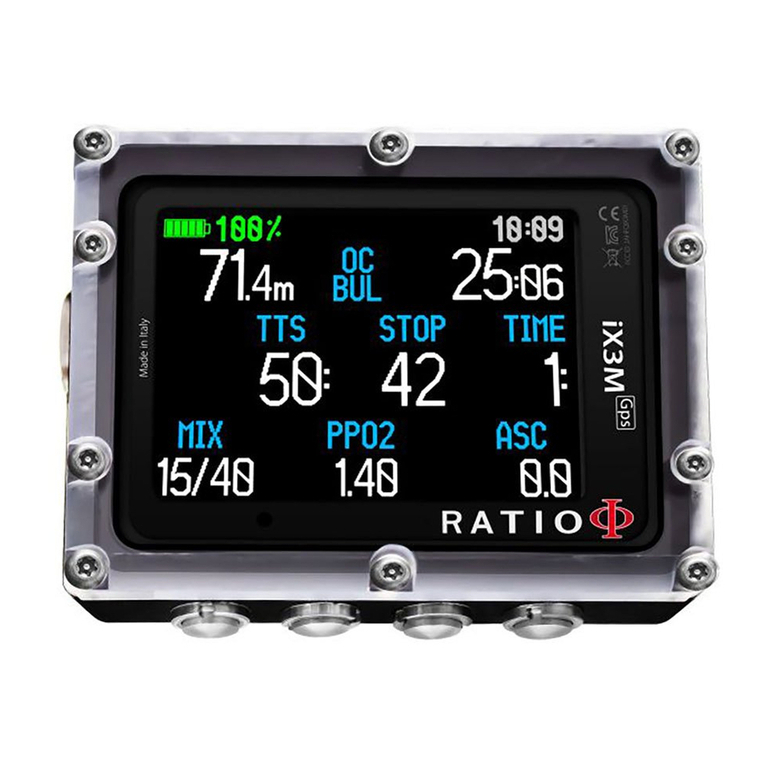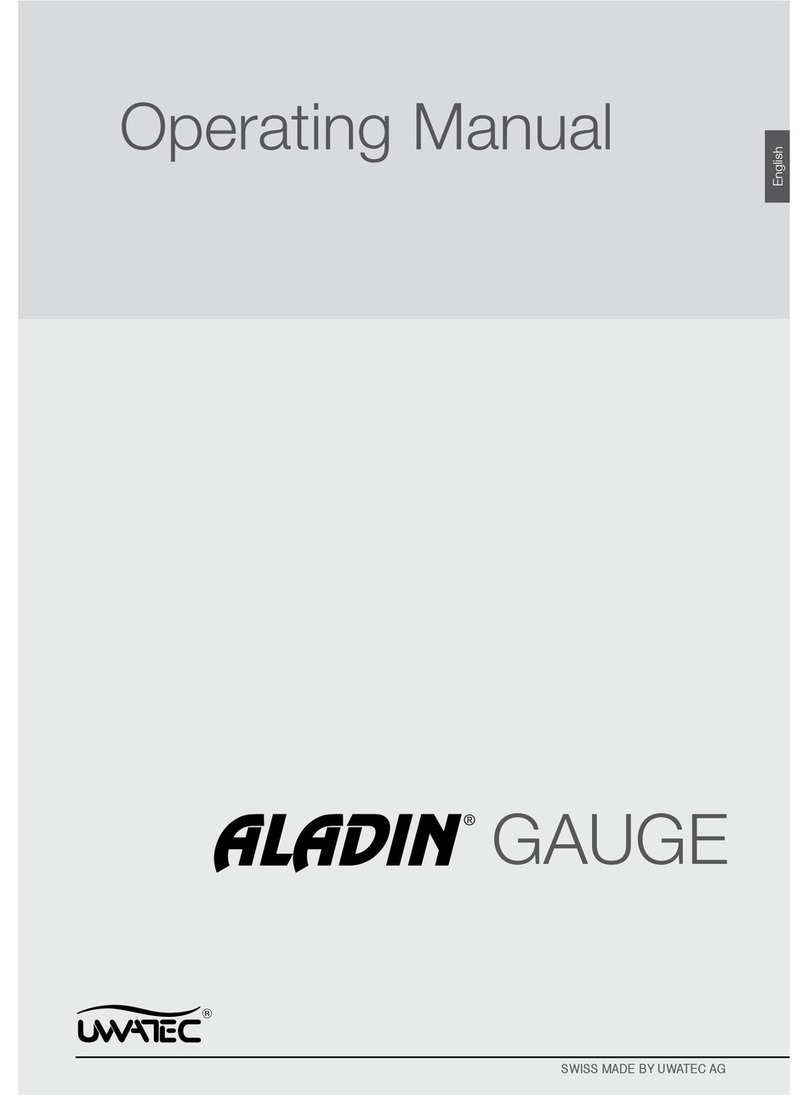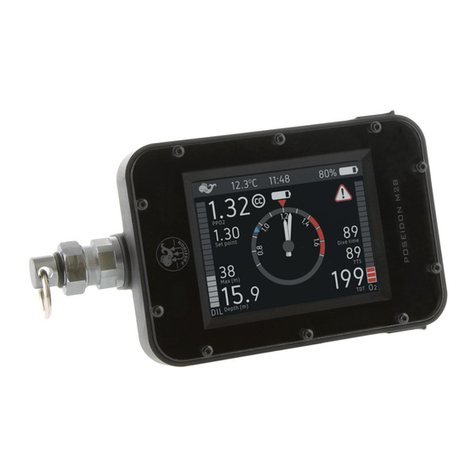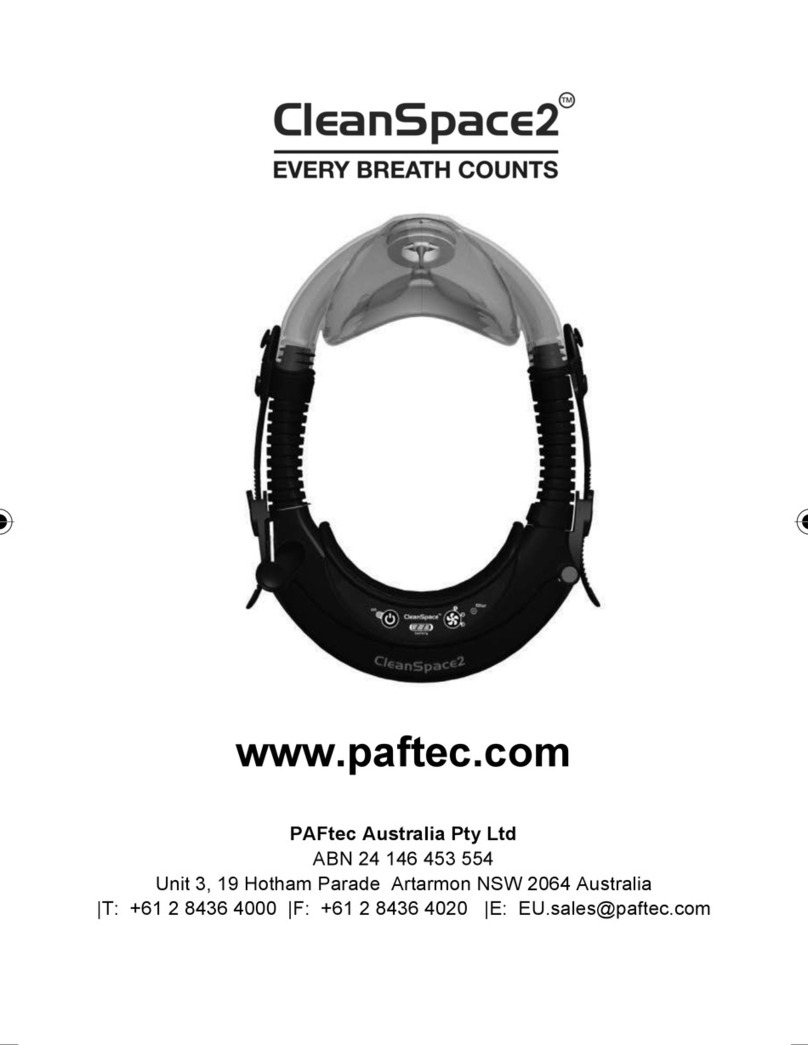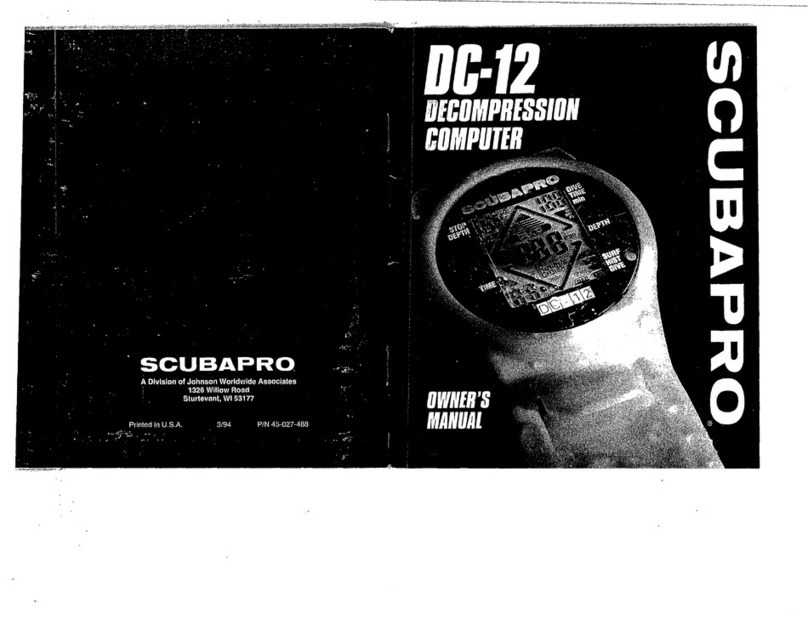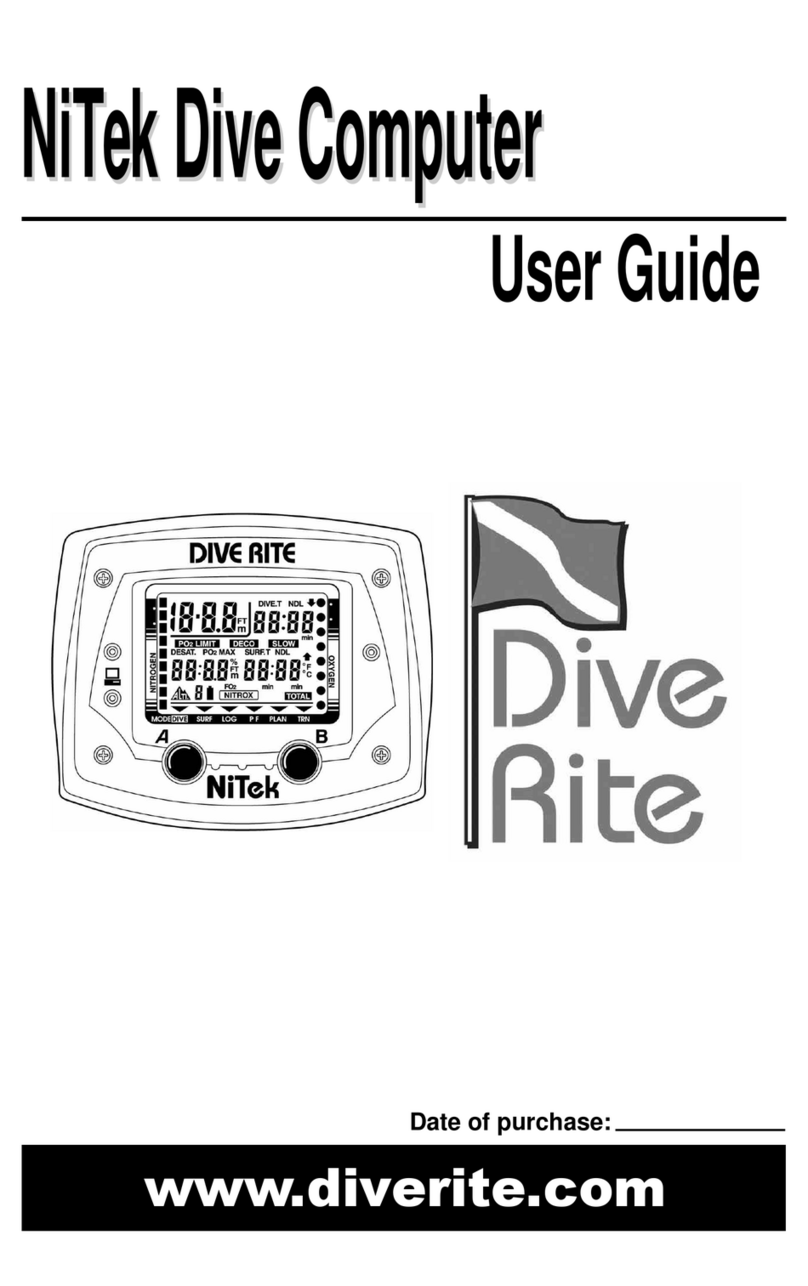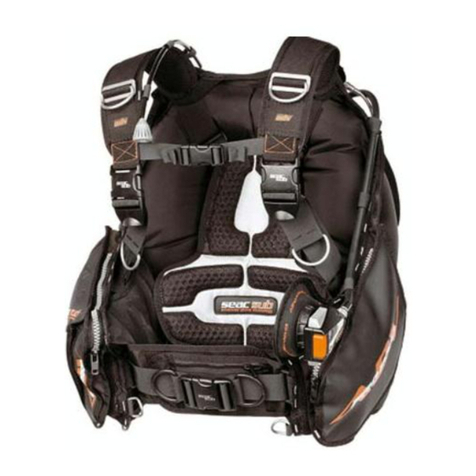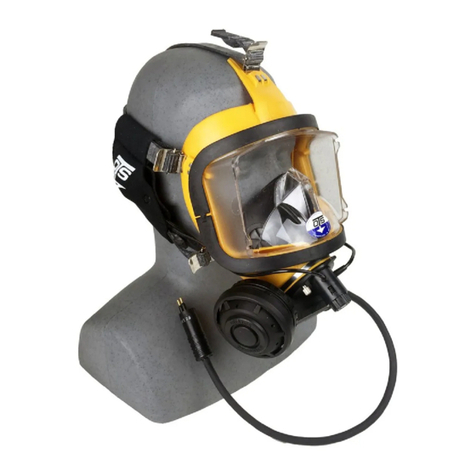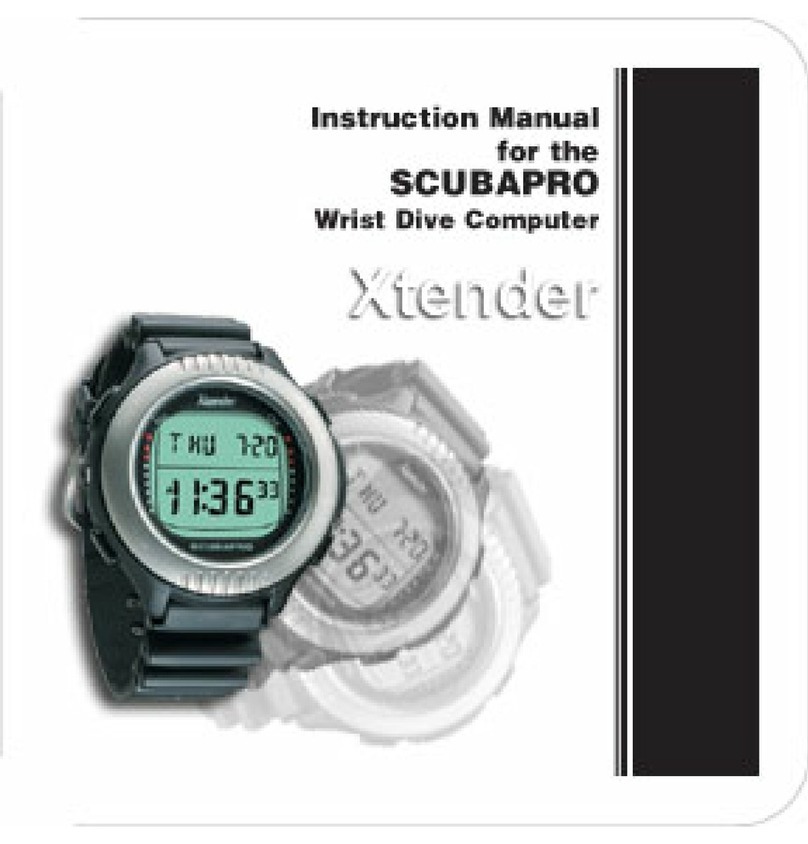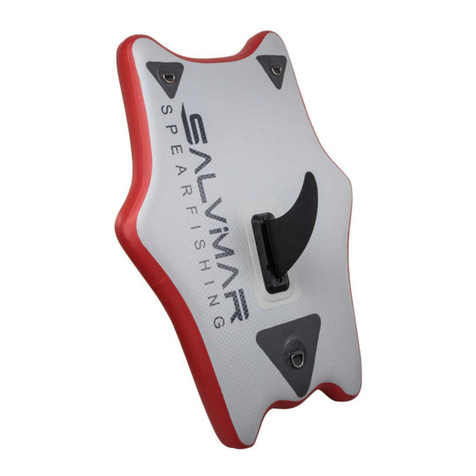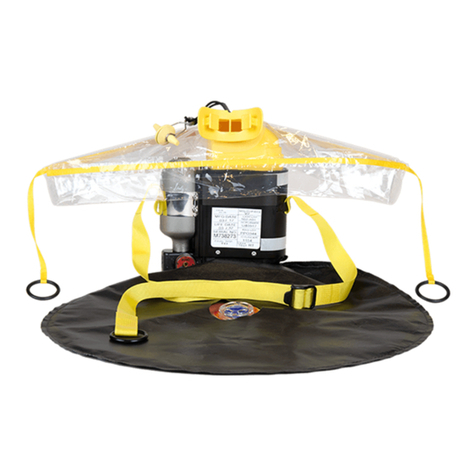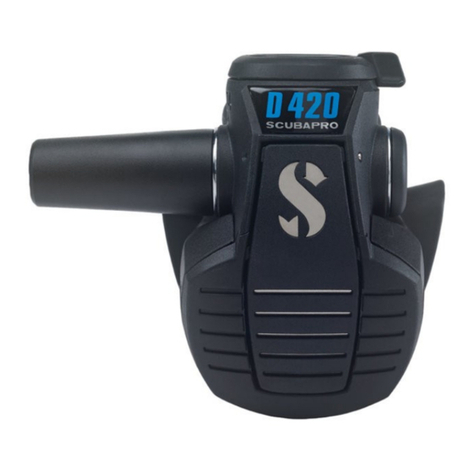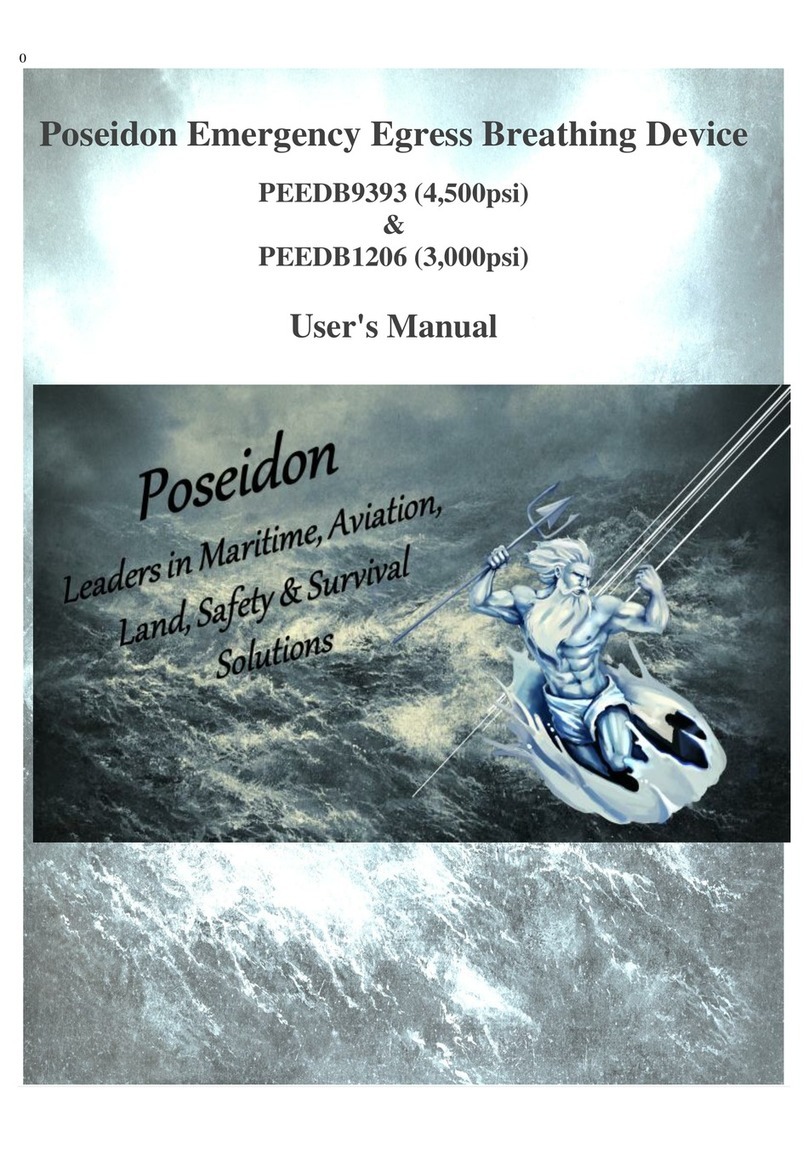Dacor DARWIN User manual

DARWIN
USER’SGUIDE
LIBRETTO D’ISTRUZIONI
BEDIENUNGSANLEITUNG
MANUEL D’UTILISATION
MANUAL DE INSTRUCCIONES
MANUAL DE INSTRUÇÕES
dive compute
Darwin.qxd 29/03/2002 16.57 Pagina 1

CONTENTS
DARWIN DIVE COMPUTER 2
WARNINGS, CAUTIONS AND SAFETY RULES 2
QUICK GUIDE 5
TECHNICAL/FUNCTIONAL CHARACTERISTICS 6
TECHNICAL CHARACTERISTICS 6
FUNCTIONAL CHARACTERISTICS 6
OPERATING MODES 7
UTILITY FUNCTIONS 7
MONITORING OF THE BATTERY POWER LEVEL 7
AUTOMATIC SWITCH-OFF 7
DISPLAY BACKLIGHT 7
SETUP OF TECHNICAL PARAMETERS 8
DIVING WITH THE DARWIN 11
ACTIVATING DIVE MODE 11
AIR DIVE 11
"NITROX" DIVE 15
"BOTTOM TIME"17
SURFACE MODE 17
POST DIVE SURFACE TIME 17
CALENDAR AND CLOCK 18
SCROLLING OF NO DECOMPRESSION LIMITS 18
DIVE SIMULATOR 19
LOGBOOK 20
INTERFACING TO A PC 21
FAQ 21
MAINTENANCE 22
REPLACING THE BATTERIES 22
DARWIN DIVE COMPUTER
1
ENGLISH
Darwin.qxd 29/03/2002 16.45 Pagina 1

2
DARWIN DIVE COMPUTER
Congratulations. The dive computer which you have
purchased is the result of the latest DACOR
technology, and has been designed to ensure
maximum safety, efficiency, reliability and long life.
This computer is further enhanced by certain
innovative features, which place it at the top of the
DACOR product range.
Operating modes: "Air", "Nitrox", "Bottom Time".
"Bottom Time" with seconds display.
Optical port for uploading data to a PC.
Increased Logbook capacity (approximately 38
hours of profiles, with points at 20 sec
intervals).
Timer-controlled or permanent backlighting.
In this manual you will discover all the other
functions that make DARWIN one of the most
complete computers available on the market today.
You will find all the instructions for learning how
to use the DARWIN computer and its functions.
DACOR thanks you for your choice and urges you
to always practice safe and responsible diving.
WARNINGS, CAUTIONS AND
SAFETY RULES
Important:
Any critical information or warnings that might
affect the performance or result in the injury of
the technician, COMPUTER DARWIN owner, or other
persons are highlighted with the following
symbols:
Before diving, make sure you have read and
understood the entire instruction manual.
!WARNING
Do not dive if the instrument display
seems anomalous or unclear.
!WARNING
Before the dive, check that the units of
measurement have been set correctly.
Incorrect settings might cause confusion
resulting in underwater behavior errors.
!WARNING
In addition to the dive computer, also
use a depth gauge, a submersible
pressure gauge, a timer or watch, and
dive tables.
!WARNING
The dive computer cannot prevent
possible decompression problems.
The dive computer cannot take into
account the physical conditions of the
individual diver, which may vary from one
day to the next.
For your safety, have a general medical
check-up before undertaking a dive.
!WARNING
The DARWIN computer is designed
exclusively for recreational sports use
and not for professional applications.
!DANGER
Indicates an imminently hazardous
situation which, if not avoided, will
result in death or serious injury.
!WARNING
Indicates a potentially hazardous
situation which, if not avoided, could
result in death or serious injury.
!CAUTION
Indicates a potentially hazardous
situation which, if not avoided, may
result in minor or moderate injury. It
may also be used to alert against
unsafe practices.
Darwin.qxd 29/03/2002 16.45 Pagina 2

The safety of a dive can only be assured by
adequate preparation.
DACOR recommends taking a specialist training
course before diving with a dive computer.
DACOR recommends scrupulous observance of the
simple safe diving rules set out in the paragraph
on "responsible diving practices".
RESPONSIBLE DIVING PRACTICES
Always plan your dives in advance.
Never exceed the limits of your skill and
experience.
Go to the deepest planned depth at the
beginning of the dive.
Check your computer frequently during the dive
Comply with the ascent rate indicated by the
computer.
Always do a safety stop at 10 - 16 feet (3 - 5
meters) for at least 3 minutes.
After the safety stop, ascend very slowly to
the surface.
Avoid yo-yo dives (repeatedly ascending and
descending underwater).
Avoid strenuous activity during the dive and
for half an hour after surfacing.
When diving in cold water or in the case of a
strenuous dive, start ascending well before
reaching the NO DECO limits.
If it is a decompression dive, prolong the
decompression stop nearest to the surface by
several minutes.
Repetitive dives should be separated by a
surface interval of at least 2 hours.
Your deepest dive should be the first one of
the day.
Avoid diving until the computer memory has
cleared from the preceding day's dive.
When doing repetitive dives for several
consecutive days, take at least one day off from
diving every week. In the case of
decompression-stop diving, it is recommended to
take one day off from diving every three days.
Avoid planned decompression dives and do not
dive deeper than 130 feet (40 meters) unless
you have been specifically trained in this type
of technical diving.
Avoid repetitive "square profile" dives (dives to
a single depth) deeper than 60 feet (18 meters).
Always wait as long as possible before flying
after a dive (at least 12 and preferably 24
hours), in accordance with the recommendations
of the Divers' Alert Network.
!WARNING
Before starting a "Nitrox" dive, check
that the dive computer is set to
"Nitrox" mode, then check the
composition of the breathing mix you
will be using and enter its oxygen
percentage in the appropriate SET
function.
Entering an incorrect oxygen percentage
will lead to errors in the readouts for:
- no-decompression time remaining;
- decompression stop times;
- alarm for exceeding the maximum
permitted O2partial pressure.
!WARNING
The use of oxygen-rich mixtures exposes
the diver to different hazards from those
associated with compressed air. The diver
must be aware of these risks and
understand how to avoid them.
!WARNING
DARWIN may be used with oxygen-rich
mixtures (nitrox) ONLY by suitably
trained and certified divers. Attempting
to dive without adequate nitrox training
might result in serious injury.
!WARNING
Do not dive in mountain lakes without
having first checked that the
appropriate altitude program is
enabled.
!WARNING
Check the battery power level before
starting your dive.
Do not dive if the <battery> icon
indicates that the battery is low. Replace
the batteries.
DARWIN DIVE COMPUTER
3
ENGLISH
Darwin.qxd 29/03/2002 16.45 Pagina 3

4
DACOR recommends that divers never exceed the
maximum permitted depth for their qualification.
Diving below 130 feet (40 meters) or outside the
no-decompression limits significantly increases the
risk of decompression sickness.
Always ascend several minutes before going into DEC
mode, and allow yourself even more time in the case
of cold water conditions, repetitive dives deeper
than 60 feet (18 m), or for any dive involving
unusually high exertion. Failure to do this will
increase your risk of decompression sickness.
Do not compress your DARWIN computer in a
hyperbaric chamber. The instrument can be
seriously damaged if it is not submerged in water.
!WARNING
Never fly within 24 hours of your last
dive, or in any case wait until the
DARWIN <no-fly> indication disappears.
!WARNING
NEVER use your COMPUTER or any other
dive computer for repetitive "square
profile" dives (dives to the same or nearly
the same depth) deeper than 60 feet (18
m). This is an unsafe diving practice
which will greatly increase your risk of
DCS, regardless of what your COMPUTER
reads.
!WARNING
NEVER dive alone. DARWIN cannot
replace the assistance provided by a
diving buddy.
!WARNING
NEVER dive deeper than 130 feet (40 m)
or do planned decompression dives with
the COMPUTER unless you are a trained
and certified technical diver (IANTD, TDI,
ANDI, PSA, etc.) familiar with the skills
and risks of deep air diving, and licensed
at least to the level of Deep Air diving for
depths beyond 130 feet (40 m). Even
with this level of certification and
experience, this type of technical dive
entails a much higher risk of DCS,
regardless of the dive table or computer
used. You must be aware of and willing to
accept these risks before attempting such
a dive.
!WARNING
Recreational divers should NOT dive
deeper than 40m (130 ft). Although this
computer will continue to provide
information for compressed-air dives
deeper than 40m (130 ft.), the risk of
nitrogen narcosis and decompression
sickness (DCS) is greatly increased;
therefore this information should be
treated as only approximate.
Darwin.qxd 29/03/2002 16.45 Pagina 4

QUICK GUIDE
1 <MODE> BUTTON.
2 <-> BUTTON.
3 DIVE - dive time.
DIVE - temperature.
CLOCK - year.
LOGBOOK - dive n°.
4 DIVE - depth.
DIVE - maximum depth.
CLOCK - month.
5 DIVE - no decompression time remaining.
DIVE - duration of the specified.
decompression stop.
DIVE - total ascent time.
CLOCK - date.
Bottom Time indicator, "Bt".
6 Decompression stop depth.
CLOCK - hour.
7 DIVE - % CNS O2.
DIVE - % O2.
CLOCK - minutes.
6+7 SURF - surface time.
SURF - "no fly" time.
SURF - desaturation time.
Stop Mode indication, "StoP".
8 % ascent rate.
9 Decompression stop depth indicators.
10 Omitted decompression stop indicator.
11 Uncontrolled ascent indicator.
12 Max % CNS O2error indicator.
13 Low battery indicator.
14 "No fly" indicator.
15 "Desat" indicator.
16 Altitude level.
17 Unit of depth measurement.
18 Unit of temperature measurement.
19 Fresh / seawater program selection.
20 Nitrox dive indicator.
21 Active mode indicator.
DARWIN DIVE COMPUTER
5
ENGLISH
Darwin.qxd 29/03/2002 16.45 Pagina 5

6
TECHNICAL FUNCTIONAL
CHARACTERISTICS
TECHNICAL CHARACTERISTICS
DEPTH MEASUREMENT:
Maximum displayed depth: 150 m (495 ft).
Measurement resolution: 10 cm in the 0-100 m
range / 1 m in the 100-150 m range.
Temperature compensation of the measurement.
Measurement accuracy: from 0 to 80 m, ±1% of
full scale.
Calibration in fresh water.
Difference in sea water: 2.5%.
TEMPERATURE MEASUREMENT:
Measurement range: -10 / +50 °C (14/122°F).
Measurement resolution: 1°C.
Measurement accuracy: ±2°C (±2°F).
ALGORITHM:
11 tissues from 2.5 to 480.
Deterministic-exponential algorithm, with M
values (low bubble) derived from the Rogers
and Powell studies conducted using Doppler
methods (modified Haldanean).
Deterministic-exponential algorithm, with M
values (low bubble) derived from the Rogers
and Powell studies conducted using Doppler
methods (modified Haldanean).
Display backlight: timer-controlled and
permanent
Power supply: 2 alkaline 1.5 V batteries (type
AAA) easily replaceable by the user.
Battery life:
Approximately 12 months with 50 dives
and occasional use of the backlight.
Approximately 10 dives with the backlight
always on.
Operating temperature: from -10 to +50°C
(14/122°F).
Storage temperature: from -20 to +70°C
(-4 /+158°F).
FUNCTIONAL CHARACTERISTICS
Operating modes:
“Air”.
"Nitrox".
"Bottom Time".
Stop Mode: lockout in case of omitted stop
and/or uncontrolled ascent (unless disabled by
the user).
Depth display: meters/feet.
Temperature display: °C/°F.
Fresh/sea water selection: manual.
Altitude programs:
P0 (0-700 m) (0-2300 ft).
P1 (700-1500 m) (2300-4900 ft).
P2 (1500-2400) (4900-7900 ft).
P3 (above 2400 m) (above 7900 ft).
Decompression stops: up to 24 meters (79 feet).
Differentiated ascent rate: from 10 to 18
m/min (33 to 59 ft/min).
Audible alarms, which can be disabled:
Low battery.
Deco stop depth violation.
Excessive ascent rate.
No decompression limits reached.
Maximum permitted depth for the
programmed value of max PPO2.
Simulator mode.
Scrolling of no-decompression limits: from 12
to 48 meters (39 to 157 feet).
Calendar clock: Year, month, date, hour,
minutes (leap year management).
PC Interface: Optical, with RS232 serial
adapter.
User programmable parameters (via the buttons
or the PC interface):
"Air"/"Nitrox"/"Bottom Time".
Percentage Oxygen in Breathing Mix (from
21% to 50% in increments of 1%).
Max PPO2(from 1.2 to 1.6 bar) (from 17.4
to 23.2 psi).
Altitude program.
Temperature measurement unit: °C / F.
Depth measurement unit: meters / feet.
Fresh/sea water.
Audible alarms (on/off).
Stop mode on uncontrolled ascent
(on/off).
Calendar clock settings.
Clear residual nitrogen memory.
History:
Total number of dives logged.
Total dive hours and minutes logged.
Greatest depth logged.
Coldest temperature logged.
Dives stored in logbook: 50 with profile for a
maximum of approximately 38 hours.
Profile point interval: 20 Sec.
Data stored in logbook:
Start date and time of the dive (year,
month, date, hour and min).
Dive settings:
Operating mode: "Air", "Nitrox",
"Bottom Time".
Salt/Fresh.
Darwin.qxd 29/03/2002 16.45 Pagina 6

Altitude program.
% O2in the breathing mix.
Maximum permitted O2partial pressure
setting (PPO2max).
Technical data:
Dive duration.
Max depth (resolution 10 cm).
Min temperature.
% CNS O2at start of dive.
% CNS O2at end of dive.
Underwater behavior errors:
Temporary overshoot of deco stop.
Omitted deco stop.
Excessive ascent rate.
Uncontrolled ascent.
Exceeded maximum permitted partial
pressure of O2.
Exceeded max permitted % CNS O2.
Profile points at 20 second intervals:
Max depth reached within each interval
(resolution 10 cm).
Excessive ascent rate.
Omitted deco stop.
Deco / no deco.
OPERATING MODES
The nine operating modes of the DARWIN dive
computer are listed below:
1. OFF mode.
2. DIVE mode.
3. SURF mode.
4. SET mode.
5. CLOCK mode.
6. PLAN mode.
7. SIMUL mode.
8. LOGBOOK mode.
9. PC mode.
As shown in Fig. A, it is possible to advance from
one mode to the next by pressing <Mode>, or to
go back to the preceding mode by pressing <->.
UTILITY FUNCTIONS
MONITORING OF THE BATTERY POWER
LEVEL
The DARWIN periodically monitors the battery
power level. If the battery power is found to be
low (level 1), an audible alarm is sounded, the
battery icon appears and the display backlight
function is disabled.
If battery power level 1 is reached during a dive,
the battery icon appears but the audible alarm is
inhibited.
From the time when the battery icon first appears,
it is possible to do 5 more dives (see chapter FAQ).
When the battery reaches its lowest power level
(level 2), the "off bAt" message appears, Fig. 1, and
the DARWIN is disabled.
FIG. 1
Even if the dive computer is not used, the
batteries should be replaced at least every 12
months.
AUTOMATIC SWITCH-OFF
If the DARWIN is ON but no buttons are pressed for a
certain amount of time, it will automatically switch
itself OFF. The delay before automatic switch-off
varies depending on the current operating mode.
DIVE - PreDive 10 min
DIVE - Dive NEVER
SIMUL - Dive, PostDive and Surface 15 min
LOGBOOK - automatic scrolling of the profile10 min
Under all other conditions 3 min
The switch-off delay timer is cleared whenever a
button is pressed, and in PC mode it is cleared at
each transmission.
After a dive, if the no-fly time is not zero, the
DARWIN switches to OFF mode but the display
remains active, showing some information. When the
no-fly time goes to zero the display switches off.
DISPLAY BACKLIGHT
The illumination of the backlight is enabled in
DIVE Mode and can be activated in two ways:
PREDIVE
15 sec timer-controlled: press the <-> button
for approximately 2 sec.
DIVE
15 sec timer-controlled: press and release the
<-> button.
Always on: press the <-> button for
approximately 2 sec; the backlight can then be
switched off by pressing the <-> button again.
DARWIN DIVE COMPUTER
7
ENGLISH
Darwin.qxd 29/03/2002 16.45 Pagina 7

8
SETUP OF TECHNICAL
PARAMETERS
SET mode can be accessed, as shown in Fig. A, by
pressing the <Mode> button from DIVE or SURF
mode, or by pressing the <-> button from CLOCK
mode.
SET mode is subdivided into five function groups,
SET1.... SET5, as shown in Fig. B. It is possible to
navigate through the different SET function groups
in the following manner:
To enter a given SET function group, press the
<Mode> button for approximately 2 sec.
Alternatively, press and immediately release the
<Mode> button to skip to the next SET function.
Press and immediately release the <-> button to
go back to the preceding SET function.
From SET5, pressing the <Mode> button saves any
changes made to the settings and goes on to
CLOCK mode. The parameters within a given SET
function group are modified using the <-> button.
SET1 - SETUP OF "AIR", "NITROX",
"BOTTOM TIME" OPERATING MODE
AND ASSOCIATED PARAMETERS
The display initially shows the following
parameters, (fig. 2):
"Nitrox" icon.
"Air".
"Gauge" (botton time).
FIG. 2
To enter SET1 press the < Mode > button for
approximately 2 sec.
Alternatively, to advance to SET2, press and
immediately release the <Mode> button .
OPERATING MODE SETUP: "AIR", "NITROX",
"BOTTOMTIME"
The display shows the currently active operating
mode. Press the <-> button to change the
setting.
If 'Nitrox' mode is selected, pressing the
<Mode> button will advance to the setup of %
O2and then of max PPO2. Otherwise, if "Air" or
"Bt" mode is selected, pressing the <Mode>
button advances to SET2.
"NITROX" BREATHING MIX SETUP
The percentage of O2in the breathing mix can
be entered in the range between 21% - 50%, in
increments of 1% (fig. 3). Press the <-> button
to increase the percentage. Press the <Mode>
button to save the percentage value and
advance to the next parameter.
FIG. 3
!WARNING
It is essential to correctly set the
oxygen percentage in the breathing mix
to ensure correct readouts of:
- no decompression time remaining
- decompression stop times
- alarm for exceeding maximum
permitted PPO2.
!WARNING
Do not use mixes with an O2% greater
than 50%.
!WARNING
If you have completed a NITROX dive and
are planning a repetitive dive using
compressed air, set your dive computer
for NITROX mode with a % O2of 21%. In
this way, the monitoring of the % CNS O2
will remain active.
Darwin.qxd 29/03/2002 16.45 Pagina 8

MAXIMUM O2PARTIAL PRESSURE SETUP
The maximum partial pressure of O2, which
triggers an alarm if exceeded, can be
programmed between a minimum of 1.2 bar
(17.4 psi) and a maximum of 1.6 bar (23.2 psi)
in increments of 0.1 bar (1.45 psi) (fig. 4).
Increase the value by pressing the <-> button.
Press the <Mode> button to save the changes
made and advance to SET2.
FIG. 4
SET2 - MAIN PARAMETER SETUP
The display initially shows the various parameters
which can be programmed in the SET2 function
group (fig. 5):
Altitude program.
"°C" or "°F" temperature units.
"m" or "ft" depth units.
"salt" or "fresh" water.
FIG. 5
To enter SET2 press the < Mode > button for
approximately 2 sec.
To skip to SET3 press and immediately release the
<Mode> button.
To go back to SET1 press and immediately release
the <-> button.
ALTITUDE PROGRAM
On entering this setup, the currently selected
altitude program (P0, P1, P2, P3) is displayed;
press the <-> button to select the next
altitude program. Press the <Mode> button to
skip to the next parameter.
TEMPERATURE UNIT SETUP
On entering this setup, the currently selected
unit of measurement will start blinking; use the
<-> button to change the setting. Press the
<Mode> button to skip to the next parameter.
DEPTH UNIT SETUP
On entering this setup, the currently selected
unit of measurement will start blinking; use the
<-> button to change the setting. Press the
<Mode> button to skip to the next parameter.
FRESH SEA WATER SETUP
On entering this setup, the currently selected
option (fresh or seawater) will start blinking.
Use the <-> button to change the setting. Press
the <Mode> button to skip to SET3.
SET3 - OPTIONAL PARAMETER SETUP
The display initially shows the indications of the
parameters which can be programmed in the SET3
function group (fig. 6):
"BEEP".
Ascent rate icons.
To enter SET3, press the <Mode> button for
approximately 2 sec.
To skip to SET4, press and immediately release the
<Mode> button.
To go back to SET2, press and immediately release
the <-> button.
FIG. 6
BEEPER SETUP
This function is used for inhibiting or enabling
the audible alarms.
On entering this setup, the 'beep' message
appears together with the current setting (ON
or OFF).
DARWIN DIVE COMPUTER
9
ENGLISH
Darwin.qxd 29/03/2002 16.45 Pagina 9

10
Press the <-> button to change the setting.
Press the <Mode> button to skip to the
uncontrolled ascent setup.
UNCONTROLLED ASCENT SETUP
This function disables or enables the "stop" in
case of uncontrolled ascent. It can be useful
for instructors when practicing emergency
ascents, to prevent the dive computer from
locking out.
On entering this setup, the ascent rate
indicator and the currently selected option
(ON or OFF) will appear. Press <-> to change
the setting. Press <Mode> to skip to SET4.
SET4 - CALENDAR CLOCK SETUP
The display initially shows the various parameters
which can be programmed in the SET4 function
group (fig. 7):
"Time" icon.
FIG. 7
To enter SET4, press <Mode> for approximately 2
sec.
To skip to SET5, press and immediately release the
<Mode> button.
To go back to SET3, press and immediately release
the <-> button.
The display shows the current date and time, with the
date digits blinking. The blinking value can be
incremented by pressing <-> (hold down the button
for rapid increment); when the desired value is
reached, press <Mode> to save the new setting and
go on to the next value (month). After setting the
minutes, DARWIN checks the compatibility of the
date and month settings, taking leap years into
account. If the date and month are incompatible with
each other, pressing the <Mode> button returns to
the date setting instead of advancing to SET5,
prompting the user to correct the date. In this way it
is not possible to enter inexistent dates such as April
31 or February 29 2001.
SET5 - CLEAR RESIDUAL NITROGEN
MEMORY
This set function is used for clearing the residual
nitrogen memory.
The display initially shows the "desat" icon.
To enter SET5, press the <Mode> button for
approximately 2 sec (fig. 8).
FIG. 8
Alternatively, to exit SET mode and advance to
CLOCK mode, press and immediately release the
<Mode> button. To go back to SET4, press and
immediately release the <-> button.
To clear the residual nitrogen memory, press and
hold down the <-> button for at least 6 seconds.
The clearing of the nitrogen memory is confirmed
as shown in fig. 9.
FIG. 9
!WARNING
This function should only be used by
highly experienced divers who take full
responsibility for the consequences of
disabling the "stop" in case of
uncontrolled ascent.
!WARNING
The audible alarms should only be
disabled by expert divers who take full
responsibility for the consequences of
this operation.
Darwin.qxd 29/03/2002 16.45 Pagina 10

DIVING WITH THE DARWIN
ACTIVATING DIVE MODE
DIVE mode is activated by means of the buttons.
When the <Mode> button is pressed in OFF mode,
the DARWIN performs the autozero procedure
(depth calibration) and the low battery check.
Then it illuminates the display and backlight for
approximately 2 seconds and, if everything is
working correctly, the instrument goes into
PreDive mode.
If a dive is started with the DARWIN in OFF mode,
or in any state other than DIVE mode, the periodic
monitoring of ambient pressure will automatically
activate DIVE mode within a maximum delay of 30
sec after the diver has descended below 1.5 meters.
If, during the first few meters of a descent, the
diver notices that the DARWIN is off, he can press
the <Mode> button to switch it on, pre-empting
the automatic switch-on which would in any case
take place after a maximum delay of 30 sec.
If, during the first few meters of the descent, the
user notices that the DARWIN is in some mode
other than DIVE, he can use the buttons to
activate DIVE mode, pre-empting the automatic
switch to DIVE mode which would in any case take
place after a maximum delay of 30 sec.
In dives with very rapid descents it is preferable
to switch on the computer using the buttons.
AIR DIVE
The various operating phases of DIVE mode are
described below.
DIVE - WAITING TO START DIVE, PREDIVE
(FIG. 10)
This phase persists until the depth reading
exceeds 1.5 m (4.9 ft). If the PreDive state lasts
longer than 15 min without any button being
pressed, the DARWIN switches to OFF mode.
FIG. 10
DIVE - "NO DECOMPRESSION" DIVE
When the depth reading exceeds 1.5 m (4.9 ft),
the dive begins and the dive timer starts
measuring its duration. Recording of the dive data
in memory (LogBook) begins if this phases
persists for more than 20 seconds.
The dive parameters are shown in two display
layouts: WIN1 and WIN2.
WIN1 shows the following parameters (fig. 11):
Sea/fresh.
No deco icon.
current depth (in "m" or "ft").
Duration of the dive in minutes.
No decompression time remaining in minutes.
FIG. 11
Pressing the <Mode> button switches over, for
approximately 8 seconds, to the WIN2 display
layout which shows (fig. 12):
Salt/fresh.
No deco icon.
Maximum depth reached (in "m" or "ft").
Water temperature (in °C or °F).
No decompression time remaining expressed in
minutes.
After 8 seconds, or when the <Mode> button is
pressed, the display automatically reverts to the
WIN1 layout.
!WARNING
This function should only be used by
expert divers. A diver who clears the
residual nitrogen memory cannot use the
instrument for repetitive dives. After
clearing the residual nitrogen memory,
wait at least 24 hours after your last
dive before using the DARWIN again.
DARWIN DIVE COMPUTER
11
ENGLISH
Darwin.qxd 29/03/2002 16.45 Pagina 11

12
FIG. 12
When the no decompression time remaining is 1
min, an audible alarm is sounded to indicate that
the diver is about to exceed the no decompression
limits.
DIVE - "DECOMPRESSION STOP" DIVE
If the diver does not ascend when the above alarm
is sounded, the DARWIN will start calculating a
"decompression stop" dive, indicated by the
appearance of the "deco" message and an audible
alarm.
The dive parameters are displayed in the WIN1 and
WIN2 layouts as follows:
WIN1 shows the following information (fig. 13):
Sea/fresh.
"Deco" icon.
Current depth (in "m" or "ft").
Duration of the dive expressed in minutes.
Depth of deepest decompression stop.
Duration of the decompression stop in
question.
FIG. 13
Pressing the <Mode> button switches over, for
approximately 8 seconds, to the WIN2 layout
which shows (fig. 14):
Salt/fresh.
"Deco" icon.
Maximum depth reached (in "m" or "ft").
Measured temperature (in °C or °F).
Ascent time, i.e. the total time necessary for
surfacing.
FIG. 14
After the 8 seconds have elapsed, or when the
<Mode> button is pressed, the display
automatically reverts to the WIN1 layout.
The ascent time is given by the sum of:
the durations of the various decompression
stops (excluding the Safety Stop time, which is
always recommended).
the time required to ascend at an average
speed of 15m/min (49ft/min).
The DARWIN will also check that the decompression
stops are performed correctly; two icons (fig. 15),
graphically indicate what action the diver should
take:
2 triangles: correct decompression stop depth;
upward triangle: diver below decompression
stop depth, ascend;
downward triangle: diver has ascended above
decompression stop depth, descend!!
FIG. 15
If the diver overshoots the decompression stop
depth by more than 30 cm (11.8 in), the
"downward triangle" icon starts blinking; if the
overshoot exceeds 1 m (3.28 ft), an audible alarm
is sounded in addition to the blinking icon. These
!WARNING
Never ascend above the correct
decompression stop depth.
Darwin.qxd 29/03/2002 16.45 Pagina 12

warnings remain active until normal conditions are
restored.
If the decompression stop overshoot exceeds 1
meter (3.28 ft) and lasts more than 3 minutes, the
computer switches to Omitted Stop mode.
In this case, the corresponding icon appears (fig. 16).
FIG. 16
If, after surfacing, the diver attempts a repetitive
dive, the DARWIN will function only as a depth gauge
(Stop Mode).
DIVE - ASCENDING
A reduction in depth activates an ascent rate
monitoring algorithm. The dive computer shows a
graphic indication of the diver's ascent rate as a
percentage of the optimal value, given in the table
below:
Depth Optimal ascent rate
Less than 10 m (32.8 ft) 10 m/min (32.8 ft/min)
Between 10 m and 20 m
(32.8 and 65.6 ft) 12 m/min (39.4 ft/min)
More than 20 m (65.6 ft) 18 m/min (59 ft/min)
If the diver's speed of ascent reaches 60% of the
maximum permitted ascent rate for the current depth,
the corresponding graphic indicator will appear.
The correspondence between the bars and the
percentage of the optimal ascent rate is as
follows:
1 bar (14.5 psi) 60 < % speed < 80
2 bars (29 psi) 80 < % speed < 95
3 bars (43.5 psi) 95 < % speed < 105
4 bars (58 psi) 105 < % speed < 120
4 bars (58 psi) + "Slow" % speed > 120
If the "Slow" message appears, an audible alarm is
sounded which persists until the diver's speed of
ascent drops below 120%.
If the diver's ascent rate is sufficiently fast to
trigger the audible alarm, the computer begins
monitoring an uncontrolled ascent.
An ascent is considered to be "uncontrolled" when
the maximum ascent rate is exceeded (SLOW with
audible alarm) for a stretch equal to at least 2/3 of
the depth at which the audible alarm started
sounding. This criterion only applies to alarms
triggered below a depth of 12 meters (39.4 feet).
In the event of an uncontrolled ascent (fig. 17), if
the user attempts a repetitive dive after surfacing,
the DARWIN will function only as a depth gauge
(Stop Mode).
The "STOP after uncontrolled ascent" function can
be disabled in SET3.
FIG. 17
DIVE - SAFETY STOP
If the maximum depth of a dive exceeds 10
meters (32.8 feet) a "Safety Stop" is activated for
the ascent; the DARWIN will then suggest a 3
minute safety stop at a depth between -2.5 and -
5 meters (-8.2 and -16.4 feet), replacing the no-
dec time of 99 min with the message "St 3
min…2min…1min" (fig. 18). If the diver moves
outside the above mentioned depth range, the no-
dec time reappears on the display, and the safety
stop timer is stopped. When the diver re-enters
!WARNING
The above option is intended only for
highly experienced divers, who take full
responsibility for the consequences of
disabling the function which locks out
the computer in case of an uncontrolled
ascent.
!DANGER
An excessive speed of ascent increases
the risk of decompression sickness.
!WARNING
When the omitted deco stop alarms are
triggered, desaturation of the simulated
tissues is halted; it resumes when the
diver returns to the correct
decompression stop depth.
DARWIN DIVE COMPUTER
13
ENGLISH
Darwin.qxd 29/03/2002 16.45 Pagina 13

14
the safety stop depth range, the safety stop timer
resumes from where it left off. If the diver returns
below 10 meters (32.8 feet), the safety stop timer
ignores the aborted stop and will subsequently
start counting down from 3 minutes again.
In the case of decompression-stop dives, the
computer will extend the duration of the stop at 3
meters (9.8 feet) by an additional 3 minutes,
displaying the safety stop information as
described above.
FIG. 18
DIVE - SURFACING
When the measured depth is less than 1 meter
(3.28 feet), the dive is suspended and the dive
timer is stopped. If the diver does not return
below 1.5 meters (4.9 feet) within the next 10
minutes, the DARWIN considers dive to be
completed and records its data in the LogBook;
otherwise the dive continues and the DARWIN
resumes the dive timer count.
The display shows (fig. 19):
Duration of the dive.
Maximum depth.
FIG. 19
After 10 minutes, the DARWIN switches from DIVE
mode to OFF mode, and shows the following data
(fig. 20):
the No-fly icon until the no-fly time goes to zero;
desaturation time and icon, until the
desaturation time goes to zero;
any icons for underwater behavior errors
(omitted stop, uncontrolled ascent).
FIG. 20
DIVE - STOP MODE
In the event of an omitted stop and/or
uncontrolled ascent, the DARWIN will lock out and
function only as a depth gauge for any subsequent
dives.
The WIN1 display shows (fig. 21):
Depth.
Dive time.
"Stop".
FIG. 21
Pressing the <Mode> button switches over, for
approximately 8 sec, to the WIN2 display which
shows (fig. 22):
Maximum depth of the dive which triggered
Stop Mode.
Duration of the dive which triggered Stop
Mode.
"Attn".
!WARNING
Do not fly while the no-fly icon is
illuminated.
Darwin.qxd 29/03/2002 16.45 Pagina 14

FIG. 22
After the 8 seconds have elapsed, or when the
<Mode> button is pressed, the computer
automatically reverts to the WIN1 display.
If the user attempts to dive while the computer is
in Stop Mode, the profile will nevertheless be
recorded in the logbook.
Stop Mode lasts for 24 hours. The DARWIN can be
released from this condition by clearing the residual
nitrogen memory.
"NITROX" DIVE
Due to the lower percentage of nitrogen in the
breathing mix, diving with oxygen-rich mixtures
carries a lower risk of decompression sickness than
diving with compressed air. However,
the higher oxygen content of the mix exposes the
diver to oxygen toxicity hazards which do not
generally occur in recreational diving with
compressed air. The DARWIN monitors the dive
time and depth and, on the basis of the oxygen
percentage entered in the SET function, provides
indications which allow the diver to remain within
the safety limits for oxygen exposure.
To do a Nitrox dive, it is necessary to choose the
NITROX option in SET1.
The DARWIN handles "Nitrox" dives in a similar
manner to compressed air dives, with the same
phases and procedures for activating DIVE mode.
The only differences between compressed-air and
Nitrox dives concerns the monitoring of critical
"Nitrox" dive parameters, and the display of these
parameters in addition to the normal air dive
parameters (described in the preceding chapter).
The following section describes the critical
"Nitrox" dive parameters monitored by the
DARWIN, and the differences in the data display
layouts.
CHECKING THE CRITICAL NITROX DIVE
PARAMETERS
OXYGEN PARTIAL PRESSURE
When the diver reaches a depth at which the PPO2
exceeds the maximum permitted value entered in
the corresponding SET, (from 1.2 to 1.6 ATM), an
alarm condition is triggered indicated by:
Blinking depth indication.
Audible alarm.
The alarm persists until the diver ascends
sufficiently for the oxygen partial pressure to
return within the acceptable limits.
!WARNING
Before reading the "Nitrox Dive"
chapter, the user is advised to carefully
read the "Air Dive" chapter.
!WARNING
Correctly setting the percentage of
oxygen in the breathing mix is
indispensable for ensuring correct
readouts of:
- no decompression time remaining;
- decompression stop times;
- alarm for exceeding the maximum
permitted PPO2.
!WARNING
Do not use breathing mixes with % of
O2higher than 50%
!WARNING
Before the dive, check that the Nitrox
dive parameters have been correctly set
up:the percentage of oxygen in the mix
and the partial pressure of oxygen
partial pressure which determines the
maximum permitted depth for the dive.
!WARNING
This function should only be used by
highly experienced divers. Users who
clear the residual nitrogen memory
cannot use the instrument for repetitive
dives. Do not dive with the DARWIN
after clearing the nitrogen memory if
you have already dived within the
previous 24 hours.
DARWIN DIVE COMPUTER
15
ENGLISH
Darwin.qxd 29/03/2002 16.45 Pagina 15

16
EFFECTS ON THE CENTRAL NERVOUS SYSTEM
Oxygen toxicity exposure is monitored by means of
a CNS (Central System Calculation), based on
currently accepted recommendations for exposure
limits. This toxicity is expressed as a percentage
value, % CNS O2, ranging from 0% to 120%. The
percentage value of CNS O2is shown on the
display, and an alarm is triggered when it exceeds
75%, signaled by blinking of the value.
Fig. 23-29 show the data that is displayed during
the various phases of the dive:
Fig. 23- PreDive, on activating DIVE mode, the
display shows the % O2and the % CNS O2if it is
greater than zero.
FIG. 23
Fig. 24 - "No decompression" dive, the WIN1
display layout shows:
Nitrox icon.
Sea/fresh.
“No deco” icon.
Current depth (in "m" or "ft").
Dive duration in minutes.
No decompression time remaining in minutes.
% CNS O2.
FIG. 24
Fig. 25 - Pressing the <Mode> button switches, for
approximately 8 seconds, to the WIN2 display
layout which shows:
Nitrox icon.
Sea/fresh.
No deco icon.
Maximum depth (in "m" or "ft").
Measured temperature (in °C or °F).
No decompression time remaining expressed in
minutes.
Value entered for % O2in the breathing mix.
After the 8 sec have elapsed, or when the <Mode>
is pressed, the display automatically reverts to the
WIN1 layout.
FIG. 25
Fig. 26 - "Decompression stop" dive, the WIN1
display layout shows:
Nitrox icon.
Sea/fresh.
"Deco" icon.
Current depth (in "m" or "ft").
Dive duration expressed in minutes.
Depth of deepest decompression stop.
Duration of the decompression stop in
question.
% CNS O2.
FIG. 26
Fig. 27 - Pressing the <Mode> button switches, for
approximately 8 seconds, to the WIN2 display
layout which shows:
Nitrox icon.
!WARNING
When this alarm occurs, ascend
immediately until the alarm condition
ceases.
Darwin.qxd 29/03/2002 16.45 Pagina 16

Salt/fresh.
"Deco" icon.
Maximum depth reached (in "m" or "ft").
Measured temperature (in °C or °F).
Ascent time, i.e. the total time required to
return to the surface.
Programmed value of % O2in the breathing mix.
After the 8 sec have elapsed, or when the <Mode>
is pressed, the display automatically reverts to the
WIN1 layout.
FIG. 27
Fig. 28- Surfacing, the display shows:
the duration of the dive.
the maximum depth.
% CNS O2.
% O2.
FIG. 28
Fig. 29 - After 10 minutes DARWIN switches from
DIVE mode to OFF mode, and shows:
No-fly icon until the no-fly time goes to zero.
Desaturation time and icon until the
desaturation time goes to zero.
% CNS O2.
Icons for any underwater behavior errors
(omitted stop, uncontrolled ascent, % CNS O2).
FIG. 29
"BOTTOM TIME"
Only the dive timer (with seconds display) and
depth gauge functions are active.
WIN1 shows the following information (fig. 30):
“Gauge” icon.
Depth.
Dive time in minutes and seconds.
"Bt" message.
FIG. 30
Pressing the <Mode> button switches, for
approximately 8 seconds, to the WIN2 layout
which shows:
“Gauge” icon.
Maximum depth.
Measured temperature (in °C or °F).
"Bt" message.
After the 8 seconds have elapsed, or when the
<Mode> button is pressed, the display
automatically reverts to the WIN1 layout.
The profiles of any dives in "bottom time" mode
will be stored in the logbook together with the
other dives.
If, after a "Bt" dive, the user attempts to set "Air"
or "Nitrox" mode using SET1, the DARWIN will lock
out in Stop Mode for the next 24 hours.
SURFACE MODE
POST DIVE SURFACE TIME
Fig. A shows the different ways for accessing SURF
mode, i.e by pressing the <Mode> button from
DIVE mode or by pressing the <-> button from SET
mode. DARWIN keeps SURF mode visible for as
long as the no-fly icon is active.
To enter SURF mode, press the <Mode> button for
2 seconds (fig. C).
The display shows the surface time in hours
and minutes (fig. 31). In the case of a "Nitrox"
dive, the displayed value is replaced for
approximately 3 sec by the value of % CNS O2.
DARWIN DIVE COMPUTER
17
ENGLISH
Darwin.qxd 29/03/2002 16.45 Pagina 17

18
FIG. 31
Pressing the <-> button displays the desat time.
Pressing the <-> button again switches displaying
to the no-fly time.
Pressing the <-> button again reverts to showing
the surface time.
Pressing the <Mode> button exits SURF mode and
goes on to SET mode.
RELATIONSHIP BETWEEN DESATURATION TIME AND
NO-FLY TIME
CALENDAR AND CLOCK
Fig. A shows the different ways for accessing SURF
mode, i.e by pressing the <Mode> button from SET
mode or by pressing the <-> button from PLAN
mode.
The display (fig. 32) shows:
Year (4 digits).
Date.
Month.
Hour and minutes (in 24 h format).
FIG. 32
SCROLLING OF NO
DECOMPRESSION LIMITS
Fig. A shows the different ways for accessing SURF
mode, i.e by pressing the <Mode> button from
CLOCK mode or by pressing the <-> button from
SIMUL mode.
This function allows the user to scroll through the
no decompression limits, automatically taking into
account the current residual saturation of his body
tissues from the preceding dive.
If a "Nitrox" dive is selected, the computer also
takes into account the percentage of O2and the
max PPO2settings.
To enter PLAN mode, press the <Mode> button for
2 seconds (fig. D).
Scrolling is started by pressing the <Mode>
button, the computer displays (fig. 33):
Depth.
No decompression time remaining expressed in
minutes.
FIG. 33
Repeatedly press and release the <-> button to
increase the depth by three meters (9.8 feet) each
time, up to a maximum of 48 m (157.4 ft). For
each depth, the display shows the corresponding
no decompression time remaining expressed in
minutes.
Instead, if the two buttons are pressed
simultaneously, the computer exits PLAN mode.
If "Nitrox" mode is active, the display shows the
programmed % of O2(fig. 34).
FIG. 34
NOITARUTASED
EMIT EMITYLF-ON
evititepernoN
noisserpmocedon
evid
sruoh21÷0 sruoh21
sruoh21> noitarutaseD=
emit
noisserpmoceD
roevidpots
evidevititeper
sruoh42÷0 sruoh42
sruoh42> noitarutaseD=
emit
Darwin.qxd 29/03/2002 16.45 Pagina 18

The maximum permitted depth will vary depending
on the values entered for % O2and maximum
PPO2.
In "Bottom Time" mode, scrolling of the no
decompression limits is inhibited (fig. 35).
FIG. 35
In "Air" or "Nitrox" mode, scrolling of the no
decompression limits is inhibited if the Stop
condition is active (fig. 36).
FIG. 36
DIVE SIMULATOR
Fig. A shows the different ways for accessing SURF
mode, i.e by pressing the <Mode> button from
PLAN mode or by pressing the <-> button from
LOG mode.
The DARWIN can simulate dives taking into
account the current residual saturation of the
diver's tissues. In the case of "Nitrox" dives, the
simulation also takes into account the settings for
% O2in the breathing mix and for maximum PPO2.
If the DARWIN is in "Bottom Time" mode, the dive
simulator function is inhibited. In "Air" or
"Nitrox" mode, the dive simulator function is
inhibited if the Stop condition is active.
To enter SIMUL mode, press the <Mode> button for
2 seconds (fig. E). This simulation mode phases are:
SIMUL - WAITING TO START DIVE (FIG. 37)
Press the <-> button to start simulating the dive.
FIG. 37
SIMUL - DIVE
The simulation time runs 5 times faster than real
time. In other words, after 12 seconds of real time,
one minute will have passed in the simulated dive.
The DARWIN displays the data in the same way as
for a real dive, again dividing it into two display
layouts. At approximately 20 seconds intervals, the
WIN1 display layout is replaced by the WIN2 which
shows the maximum depth and the ascent time;
after approximately 4 seconds the display reverts
to showing the WIN1 layout.
Button functions:
Press and release the <-> button to increase the
depth by 1 meter (3.28 feet) each time.
Repeatedly press and release this button to
simulate a descent rate of 12 m/minute (39.3
ft/minute). Keep it pressed to simulate a descent
rate of 24 m/min (78.7 ft/min).
Press and release the <Mode> button to decrease
the depth by 1 meter (3.28 feet) each time.
Repeatedly press and release this button to
simulate an ascent rate of 12 m/min (39.3
ft/min). Keep the <Mode> button pressed to
simulate an ascent rate of 18 m/min (59 ft/min).
Press <Mode> and <-> simultaneously to exit SIMUL
mode.
SIMUL - SURFACING
When the depth is less than one meter (3.28 feet),
the DARWIN considers the diver to be at the
surface. The display shows the maximum depth
reached and the duration of the simulated dive.
Press the <-> button to resume the dive.
Press <Mode> and <-> simultaneously to exit
SIMUL mode.
SIMUL - POST DIVE SURFACE TIME
On surfacing from the simulated dive, the DARWIN
switches to surface mode and displays the surface
time. This value increases quickly because the
simulation time runs even faster than during dive
mode (one real-time second = one minute in the
simulated surface time). Press <Mode> to switch
to a display of the "desat time".
DARWIN DIVE COMPUTER
19
ENGLISH
Darwin.qxd 29/03/2002 16.45 Pagina 19
Table of contents


